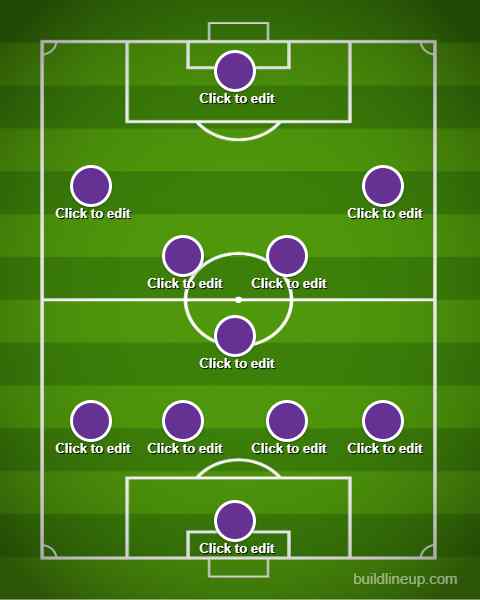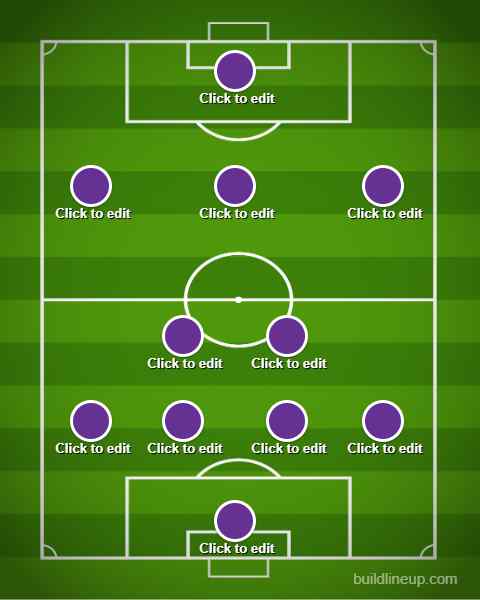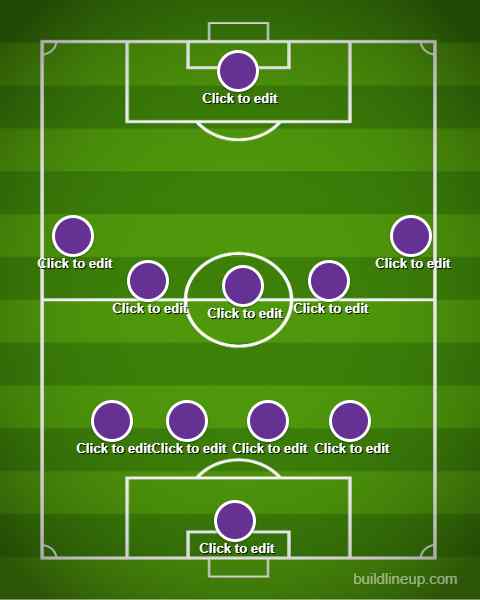When looking at the world of soccer, formations can seem like a black box and it can be hard to know what exactly a formation is, or why we see them in soccer. Soccer is a game of formations, and one of its most important aspects is the ability to change and adapt to different opponents.
The formation is just a part of the game that allows coaches to adjust to the opponent and the way the team lines up. The formation deployed in a game can make or mar a team and we’ve seen instances where it comes to play.
Soccer has evolved beyond assembling the best of stars in a team. If the manager who manages these big sides doesn’t know the effective formation to bring out the best in his stars, a small side that has been drilled properly with the right formation that brings out the best in the players would beat them.
We’ve seen lots of upsets in soccer and the formation deployed on the day played a major part.
In this article, we will take a look at the top formations in soccer in 2024 and explain further how they work and what they entail.
READ: What Is A Hat-Trick In Soccer?
The Most Popular Soccer Formations
1. 3-4-3

One of the lovers of this formation is current Tottenham Hotspur manager Antonio Conte who took the Premier League by storm during his time as Chelsea manager.
He won the Premier League title in his first season in the Premier League with the 3-4-3 formation in the 2016/17 season but faltered the next season.
Speaking of wingbacks in soccer, this is one formation where their presence and availability are essential for the team to thrive.
The formation allows for a free-flowing, fluid attacking style of soccer with the option to swiftly switch to a 5-4-1 when the side does not have the ball.
Because of the outnumbered situations it produces, the opposition will find it nearly impossible to try and mark people, and it also means that the larger areas will be much more difficult to exploit when the team does not have possession.
Furthermore, the middle portions of the soccer field are always adequately covered, with up to four players able to shift defensively and assist if one of the fullbacks is caught on the counter since they were upfield.
However, there is a major shortcoming, and that is how physically demanding the formation is on the players.
Midfielders and wide players will need to go up and down the field continually for 90 minutes, which is why N’Golo Kante was such an important element of this Chelsea side, because of his ability to get up and down the pitch.
It also requires the wingbacks (left and right back in advanced positions) to be particularly disciplined in their defensive duties, but not so much that they do not attack.
The fundamental goal of this formation, thanks to the wingbacks, is to create outnumbered situations going forward, and there is hardly another formation that relies so much on a single position.
2. 4-3-3

The 4-3-3 formation is ideal for a team that is intent on attacking for most of the game. It comprises a powerful back four and a three-man midfield that can all play various roles with both defenders and attackers.
Having three forwards is an excellent strategy to score goals, with the center forward mostly utilized to stretch the opposing backline and allow the wider players to exploit the space left behind.
The wide players in this formation such as the wingers, fullbacks, and side midfielders must have genuine pace and great technical ability to get past defenders, while the midfielders in the center should be great with possession and also be good defenders of the ball.
The 4-3-3 formation, like nearly all others, requires both fullbacks (left and right back) to assist and join in on the attack when their team has possession.
The fullbacks will need to be extremely fit because they will be required to run up and down the field continuously for the entirety of the 90-minute game. This attribute is not peculiar to the 4-3-3 formation alone, as generally, decent fullbacks should possess the aforementioned traits.
They do, however, have a key role in not just supporting their midfield teammates, but also linking up with the wingers and creating two-on-one situations so they can overlap and get into ideal crossing positions.
READ: The 11 best football streaming apps to use
The two more attack-minded midfielders in the formation should be excellent passers, dribblers, and defensive midfielders.
The front three of the 4-3-3 formation are the key figures. Both wingers will typically find a lot of space for themselves and will frequently find themselves in positions where they can use their speed and power to run at opposing defenders.
They are critical to the success of this formation, and they should have the pace to burn, the ability to make strategic runs behind the defense, the one-on-one ability to get past people, and the ability to cross and shoot at goal.
3. 4-2-3-1

This formation consists of four defenders, two defensive or holding midfielders, three offensive or creative midfielders, and a single striker upfront.
This formation is arguably the most popular in soccer presently as a significant number of teams line up with this formation on matchdays.
The back four ensures that their team has enough width both when they have possession and when they don’t.
The goal of the two defensive midfielders is to cover the area in front of the back four and seal any pockets of space that the opposition might utilize to exploit the defense.
The three creative midfielders are free to roam and use their technical ability to connect and the striker, and they can do so confidently as two defensive midfielders provide cover from behind.
Therefore, if the opposition gets through them, they also have to go through the defensive midfielders to stand a chance. As for the striker, he is also a lone figure just as in the 4-1-4-1 formation.
READ: What is a brace in soccer?
4-2-3-1 is supposed to be an attacking formation with the defensive steel of the back four and the two defensive midfielders, whether it is linking up play or delivering crosses for the striker.
The defensive midfielders in the center of the park provide the team with balance while also being significantly less predictable in both attack and defense.
When the opponent has the ball, they cover the gap and help protect the back four, which is the heartbeat of this system.
4. 4-1-4-1

This formation emphasizes having a strong defense but does not fully restrict a team’s attacking ability. This formation relies on the individual strengths of the starting eleven players. It is a formation that allows players to showcase their talents if the personnel to play the system is in place.
However, there is a disadvantage to this system in that there is only one striker upfront. The midfield is extremely compact, and the defensive midfielder has two primary responsibilities.
When the team is playing out from the back, he will form part of a four-man midfield and can then function as an extra person on defense to help protect the back four.
The system is reasonably solid with a back four, and it puts a lot of pressure on the lone holding midfielder as well as the lone striker.
If this formation is not deployed correctly, the striker may cast a lone figure in the opposition box as he would be isolated and take play no part in moving the ball forward. This is a disadvantage to the team’s midfielders.
With the 4-1-4-1 formation, the striker has to be very imposing and must be a tireless worker, know how to bring others into play when in possession of the ball, and also be a fighter.
The likes of Didier Drogba, Diego Costa, and Robert Lewandowski, amongst others, should thrive in this formation with the right personnel behind them.
READ: How Long is Extra Time in Soccer?
5. 4-5-1

This is arguably the best defensive soccer formation as it comprises two defensive midfielders whose role is to hamper the progress of the opposition players from midfield.
Being a defensive formation, it is mostly used by the minnows when they clash against the supposedly big boys.
Let’s consider a Premier League clash between Crystal Palace and Manchester City. The latter would opt for this formation to enhance their chances of getting at least a point at the blast of the final whistle.
Good communication is required by the players in this formation to avoid congestion in the middle of the park thereby leaving the defenders out of sorts and exposed if they are penetrated.
Sides that come up against this formation and a well-drilled team must put in the effort to break down the opposition or catch them napping if the chance arises.
This is one of those formations where the supposed Park-the-Bus terminology in soccer comes to play especially when the side deploying this formation is in the lead in a game.
6. 4-4-2

This formation is also very popular and can also be known as 4-1-2-1-2. It is one formation where the defense of the opposition has to contend with two typical strikers or center forwards running against them.
The system does not always appear to work as it should because the number 10 player will only play through the middle and one of the striker’s tasks is to cover one of the wide areas on the pitch.
With the way the game has evolved in recent times, the 4-4-2 diamond shape provides managers with several options that they can leverage.
This is because player roles are not specified, and players are not required to stay in a single position during a game.
READ: How long is a soccer game?
Both central midfielders and strikers can play wide and narrow, and the number 10 can practically go wherever on the field, while fullbacks can either go forward or defend.
However, it has its share of disadvantages and one is the formation’s lack of width, especially in situations where pockets of space occur.
Formation based on the quality of the opponent
1. 4-2-3-1 – The best soccer formation against a weak squad
This is because it gives the team four attacking players while having two defensive midfielders to cover the back four.
With four offensive players, there is a good probability that someone will be one one-on-one with a defender at some point throughout the game. The formation is well-balanced, with both defensive and offensive capabilities.
Because they know there are two defensive-minded players behind them, the three attacking midfielders and strikers can all work freely together.
2. 4-5-1 – Best soccer formation against a strong side
The role of midfielders in a game cannot be overemphasized and it is a no-brainer that the numbers in the middle of the park, as well as the quality of the personnel in positions, can determine the result of a game.
To stand a chance against a side with quality personnel, deploying this formation won’t be a bad idea and a positive result can be pulled off if discipline and determination are in place.
Teams can win the midfield battle against a supposedly stronger side by overloading the midfield with 5 midfielders, thereby outnumbering their opponents. It is also a defensive formation and would enhance the small team’s defensive arrangement.
Summary
We’ve listed the popular soccer formations that are trending and it should come as no surprise when you find teams lining up in any of these formations on matchday.
As explained, soccer formations help teams to adapt to their opponents and also serve to bring out the best in the players of the team in the position where they are deployed.
These formations are also deployed based on the abilities of the personnel available in a team. The small teams tend to go for a defensive setup whilst the bog boys opt for an attacking setup.
Do well to take advantage of the information in this article as we’ve noted how the various formations work, as well as their merits and demerits in this article. If you’re interested in enhancing your knowledge of soccer formations, then this article is for you.

Kenneth is a an avid soccer follower, fan and writer. He is a consistent follower of the sport and is a fan of Chelsea FC.